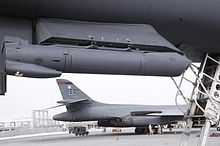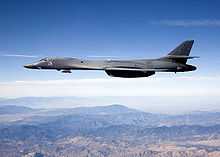Sniper Advanced Targeting Pod


The Lockheed Martin Sniper is a targeting pod for military aircraft that provides positive target identification, autonomous tracking, coordinate generation, and precise weapons guidance from extended standoff ranges.
The system has been designated AN/AAQ-33 in U.S. Military Service as the Sniper Advanced Targeting Pod (ATP). Further variants are the Sniper Extended Range (XR), as well as the PANTERA export derivative of the Sniper XR. The Lockheed Martin F-35 Lightning II is built with the equivalent of the Sniper XR in its onboard sensors.[1] The most modern version is the Sniper Advanced Targeting Pod - Sensor Enhancement (ATP-SE).
Design

The Sniper is a single, lightweight targeting pod with much lower aerodynamic drag than the legacy systems it replaces . It possesses advanced targeting technology and its image processing allows aircrews to detect and identify tactical-size targets outside threat rings for the destruction of enemy air defense mission, as well as outside jet noise ranges for urban counter-insurgency operations. It offers a 3-5 times increase in detection range over the legacy LANTIRN system . It is currently flying on the U.S. Air Force and multinational F-16, F-15, B-1B, CF-18, Harrier, A-10, B-52 and Tornado aircraft.
The pod incorporates a multi-spectral sensor capability with a high-resolution, medium-wave third-generation FLIR and a CCD-TV. Advanced sensors, combined with advanced image processing algorithms and rock-steady stabilization produce target identification ranges that permit operations minimizing exposure to many threat systems. The dual-mode laser offers an eye safe mode for urban combat and training operations, along with a laser-guided bomb designation laser for guiding in these precision munitions.
For target coordination with ground and air forces, a laser spot tracker, a laser marker, and a TV quality video down link to joint terminal air controllers improve rapid target detection and identification. The pod also provides high-resolution imagery highly sought after for non-traditional Intelligence, surveillance and reconnaissance missions.
For ease of maintenance, Sniper's optical bed design, partitioning, and diagnostic capabilities permit two-level maintenance, eliminating costly intermediate-level support. Automated built-in testing allows maintenance personnel to isolate and replace a Line Replaceable Unit in under 20 minutes to restore full mission-capable status.
The Sniper contains a laser designator and tracker for guiding laser-guided bombs. The pod also features a third-generation FLIR receiver and a CCD television camera. FLIR allows observation and tracking in low light / no light situations, while the CCD camera allows the same functions during day time operations.
In use

In August 2001, the U.S. Air Force announced Lockheed Martin's Sniper as the winner of the Advanced Targeting Pod (ATP) competition. The contract provides for pods and associated equipment, spares, and support of the F-16 and F-15E aircraft for the total force, active-duty Air Force and Air National Guard. The U.S. Air Force initial seven-year contract for Sniper ATP has potential value in excess of $843 million. The Sniper ATP has delivered over 125 pods and the U.S. Air Force plans to procure at least 522 Sniper ATPs. The follow-on Advanced Targeting Pod - Sensor Enhancement (ATP-SE) contract was split between the Lockheed Martin Sniper and the LITENING.
In 2014, the USAF declared initial operational capability for the Sniper ATP-SE which included sensor and networking improvements.[2]
The Sniper is used on the U.S. Air Force B-52H Stratofortress, B-1B Lancer, F-15E Strike Eagle, F-16 Fighting Falcon, and A-10 Thunderbolt II. It is also being used on the UK Harrier GR9[3] and the Canadian CF-18 Hornet,[4] as well as being in service with Norway, Oman, Poland, Pakistan,[5] Singapore, Canada, Belgium, Turkey, Saudi Arabia, Thailand.[6][7][8]
A team of Lockheed Martin UK, BAE Systems and SELEX Galileo (formerly Selex S&AS) has successfully demonstrated and flown a Sniper ATP on board a Tornado GR4 combat aircraft.[9]
Operators
 Egypt
Egypt
 Jordan
Jordan
 Turkey
Turkey
 UAE
UAE
 USA
USA
- USAF
 Pakistan
Pakistan
- Pakistani Air Force
 Saudi Arabia
Saudi Arabia
 Oman
Oman
 Morocco
Morocco
 Poland
Poland
.svg.png) Belgium
Belgium
- Belgian Air Force
 Canada
Canada
 Norway
Norway
 Singapore
Singapore
 Thailand
Thailand
 Romania[11]
Romania[11]
Specifications
- Primary Function: Positive identification, automatic tracking and laser designation
- Prime Contractor: Lockheed Martin
- Length: 94 inches (239 centimeters)
- Diameter: 11.9 inches (30 centimeters)
- Weight: 440 pounds (199 kilograms)
- Aircraft: F-15E, F-16 Block 30/40/50, A-10, B-1, B-52, CF-18, Harrier, Tornado
- Sensors: Mid-wave third generation Forward looking infrared, dual mode eye-safe, laser designator, Charge-coupled device-TV, laser spot tracker and laser designator
- Date Deployed: January 2005
- Inventory: Not available.
See also
- Similar devices
- LITENING
- AN/ASQ-228 ATFLIR
- LANTIRN
- ASELPOD
References
- ↑ "Newest U.S. Stealth Fighter ‘10 Years Behind’ Older Jets".
- ↑ "U.S. Air Force Declares Initial Operational Capability for Lockheed Martin’s Sniper Advanced Targeting Pod – Sensor Enhancement". www.lockheedmartin.com. Lockheed Martin. 17 March 2014. Retrieved 17 March 2014.
- ↑ "SNIPER CONTRACT A HIT FOR UK HARRIER".
- ↑ Harrington, Caitlin (March 16, 2009), Jane's Missing or empty
|title=(help) - ↑ Lockheed Martin To Supply ATP's for Pakistan Air Force F-16s - India Defence
- ↑ Saudis Seek Sniper ATP Supplementation for F-15S
- ↑ "LOCKHEED MARTIN'S SNIPER XR ADVANCED TARGETING POD TEAM CHOSEN BY AVIATION WEEK & SPACE TECHNOLOGY AS 2004 LAURELS HONOREE".
- ↑ "Belgian Air Force buys eight Sniper XR targeting pods".
- ↑ Lockheed Martin uk demonstrates Sniper advanced targeting pod on board tornado gr4
- ↑ http://articles.orlandosentinel.com/2013-06-05/business/os-lockheed-latest-foreign-sales-20130605_1_arms-sales-orlando-missiles-unit-joint-air-to-surface-standoff-missile
- ↑ https://www.fbo.gov/index?s=opportunity&mode=form&id=284856b0596b8c5fbfb1afc874e69d97&tab=core&tabmode=list&=
External links
| Wikimedia Commons has media related to Sniper Advanced Targeting Pod. |
- Lockheed Martin's Sniper ATP page
- "Sniper Targeting Pod Attacks From Long Standoff Ranges", Aviation Week & Space Technology, October 3, 2004.
| |||||||||||||||||||||||||||||||
